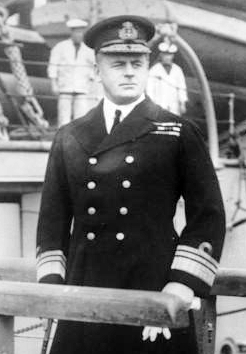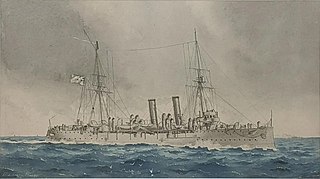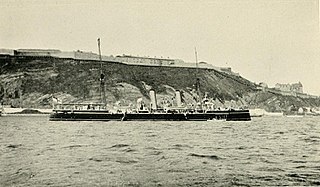
HMS Good Hope was one of four Drake-class armoured cruisers built for the Royal Navy around 1900; she was originally named Africa, but was renamed before she was launched. She became flagship of the 1st Cruiser Squadron of the Atlantic Fleet in 1906, and was the flagship of the 2nd Cruiser Squadron in 1908. She was reduced to reserve in 1913, but was recommissioned in mid-1914.

HMS Magnificent was one of the nine Majestic-class pre-dreadnought battleships of the Royal Navy. She entered service in late 1895 with the Channel Fleet, remaining with the fleet through its subsequent reorganisation into the Atlantic Fleet. In 1905, an explosion caused the deaths of 18 men but she remained in service until 1906, after which she underwent a refit. She served with the Home Fleet for most of her pre-war service.

HMS Resolution was a Royal Sovereign-class pre-dreadnought battleship of the Royal Navy. The ship was built by Palmers Shipbuilding and Iron Company, starting with her keel laying in June 1890. She was launched in May 1892 and, after completing trials, was commissioned into the Channel Squadron the following December. She was armed with a main battery of four 13.5-inch guns and a secondary battery of ten 6-inch guns. The ship had a top speed of 16.5 knots.

HMS Pelorus was the first of the Pelorus-class cruisers, and was laid down at Sheerness dockyard in 1895. Completed and commissioned into the Royal Navy in 1897, she was designed by Sir William White. Construction cost £154,315. The ship was well armed for her size, but was primarily a workhorse for the overseas fleet.

Admiral of the Fleet The Honourable Sir Hedworth Meux was a Royal Navy officer. As a junior officer he was present at the bombardment of Alexandria during the Anglo-Egyptian War.

HMS Revenge was one of seven Royal Sovereign-class pre-dreadnought battleships built for the Royal Navy during the 1890s. She spent much of her early career as a flagship for the Flying Squadron and in the Mediterranean, Home and Channel Fleets. Revenge was assigned to the International Squadron blockading Crete during the 1897–1898 revolt there against the Ottoman Empire. She was placed in reserve upon her return home in 1900, and was then briefly assigned as a coast guard ship before she joined the Home Fleet in 1902. The ship became a gunnery training ship in 1906 until she was paid off in 1913.

HMS Doris was an Eclipse-class protected cruiser built for the Royal Navy in the mid-1890s.

HMS Crescent was a first class cruiser of the Edgar class in the British Royal Navy. Crescent, and her sister ship Royal Arthur, were built to a slightly modified design and are sometimes considered a separate class. She was launched in 1892, saw early service at the Australia Station and the North America and West Indies Station, served in the First World War, and was sold for breaking up in 1921.

HMS Andromeda was one of eight Diadem-class protected cruisers built for the Royal Navy in the 1890s. Upon completion in 1899, the ship was assigned to the Mediterranean Fleet where she helped to escort a royal yacht during its cruise through the Mediterranean Sea. After a refit, she was assigned to the China Station in 1904 and returned home three years later to be reduced to reserve. Andromeda was converted into a training ship in 1913 and remained in that role under various names until 1956. That year she was sold for scrap and broken up in Belgium, the last Pembroke-built ship still afloat.

HMS Centurion was the lead ship of her class of two pre-dreadnought battleships built for the Royal Navy in the 1890s. Intended for service abroad, they exchanged heavy armour and a powerful armament for high speed and long range to counter the foreign armoured cruisers then being built as commerce raiders and were rated as second-class battleships.

HMS Barfleur was the second and last of the Centurion-class pre-dreadnought battleships built for the Royal Navy in the 1890s. Intended for service abroad, they exchanged heavy armour and a powerful armament for high speed and long range to counter the foreign armoured cruisers then being built as commerce raiders and were rated as second-class battleships.

HMS Glory was a pre-dreadnought battleship of the British Royal Navy and a member of the Canopus class. Intended for service in Asia, Glory and her sister ships were smaller and faster than the preceding Majestic-class battleships, but retained the same battery of four 12-inch (305 mm) guns. She also carried thinner armour, but incorporated new Krupp steel, which was more effective than the Harvey armour used in the Majestics. Glory was laid down in December 1896, launched in March 1899, and commissioned into the fleet in November 1900.

HMS Highflyer was the lead ship of the Highflyer-class protected cruisers built for the Royal Navy in the 1890s. She spent her early career as flagship for the East Indies and North America and West Indies Stations. She was reduced to reserve in 1908 before again becoming the flagship in the East Indies in 1911. She returned home two years later and became a training ship. When World War I began in August 1914, she was assigned to the 9th Cruiser Squadron in the Central Atlantic to intercept German commerce raiders and protect Allied shipping.

HMS Fantome was an Cadmus-class sloop launched in 1901, transferred to the Royal Australian Navy in 1914, returned to the Royal Navy in 1920, and sold in 1924. She was the fourth ship of the Royal Navy to bear the name, which is from the French fantôme, meaning "ghost".

HMS Pyramus was a Pelorus-class protected cruiser of the Royal Navy. There were eleven "Third class" protected cruisers in the class, which was designed by Sir William White. While well armed for their size, they were primarily workhorses for the overseas fleet on "police" duties and did not serve with the main battlefleet.
HMS Perseus was a Pelorus-class protected cruiser of the Royal Navy. There were eleven "Third class" protected cruisers in the class, which was designed by Sir William White. They mainly served at overseas stations rather than with the main fleets.

HMS Pactolus was a Pelorus-class protected cruiser of the Royal Navy. There were eleven ""Third class"" protected cruisers in the class, which was designed by Sir William White. While well armed for their size, they were primarily workhorses for the overseas fleet on "police" duties and did not serve with the main battlefleet. She was scrapped in 1921.

HMS Prometheus was a Pelorus-class protected cruiser of the Royal Navy. Ten sister third class protected cruisers were built — designed by Sir William White. While well-armed for their size, they were primarily workhorses for the overseas fleet considered to be on police duties. She was sold for scrap in 1914.

HMS Proserpine was a Pelorus-class cruiser of the Royal Navy. There were eleven "Third class" protected cruisers in the class, which was designed by Sir William White. While well armed for their size, they were primarily workhorses for the overseas fleet on "police" duties and did not serve with the main battlefleet.

HMS Mutine was a Condor-class sloop of the Royal Navy. Mutine was launched on 1 March 1900. While being delivered from Birkenhead to Portsmouth an accident in Mutine's boiler rooms caused some loss of life and gave her a name as an unlucky ship before her career even began. She served on the China Station, then the Australia Station between December 1903 and February 1905 and later became a survey ship, surviving until 1932 as a Royal Naval Volunteer Reserve drill ship, the last of her class to be sold.



















